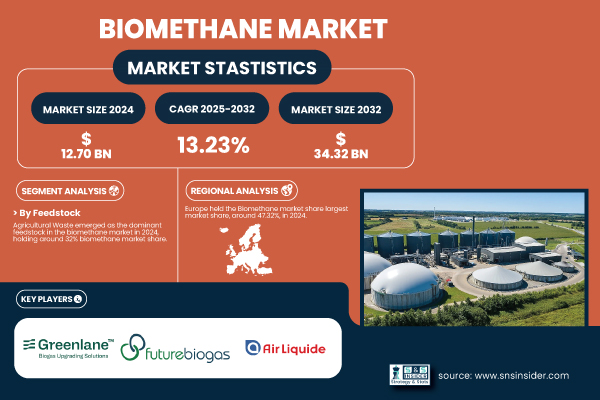The global energy landscape is undergoing a profound transformation, with biomethane emerging as a pivotal player in the transition towards sustainable and decarbonized energy systems. This cleaner, renewable natural gas, derived from organic waste, is rapidly gaining traction as a vital solution for reducing greenhouse gas emissions and fostering a circular economy. Its growing adoption across various sectors underscores its critical role in meeting ambitious renewable energy targets worldwide.
Projections indicate an impressive surge in the global biomethane market, which was valued at USD 12.70 billion in 2024 and is now forecast to skyrocket to USD 34.32 billion by 2032. This remarkable expansion is anticipated at a robust compound annual growth rate (CAGR) of 13.23% from 2025 to 2032, signaling strong investor confidence and increasing global demand for sustainable fuels. This significant market expansion highlights the accelerating shift away from fossil fuels towards greener alternatives.
The primary catalysts for this growth include the escalating utilization of biomethane for transportation, power generation, heating, and its burgeoning role as a feedstock for producing green hydrogen. Governments globally are actively fueling this momentum through attractive incentives such as feed-in-tariffs and carbon credits. Policy frameworks, particularly within the European Union, North America, and certain Asia-Pacific regions, are creating a highly favorable investment climate for biomethane production facilities, making renewable fuel mandates a key driver.
Beyond its direct energy applications, biomethane is also heralded as a crucial enabler of circular economy solutions. By efficiently converting organic waste and sewage sludge into clean energy, it addresses pressing waste management challenges while simultaneously contributing significantly to greenhouse gas reduction objectives. This inherent ability to transform waste into a valuable resource positions biomethane as a cornerstone of sustainable development.
A prominent example of this market’s dynamism is the United States, where the biomethane market size was USD 2.2 billion in 2024 and is expected to reach USD 6.64 billion by 2032, exhibiting a substantial CAGR of 14.72% over the 2025-2032 forecast period. This growth is underpinned by the nation’s mature renewable energy policies and extensive natural gas infrastructure. Complementary regulatory mechanisms, such as the Renewable Fuel Standard (RFS) and the California Low Carbon Fuel Standard (LCFS), vigorously incentivize the production and use of renewable natural gas, including biomethane, through financial credits.
Analyzing the market segments reveals distinct trends: agricultural waste dominated as the leading feedstock in 2024, commanding over a 32% global share due to its abundant supply of biodegradable residues ideal for anaerobic digestion. The transportation sector emerged as the top application, reflecting the surging demand for low-emission vehicle fuels, with biomethane variants for compressed natural gas (CNG) vehicles gaining rapid acceptance. Geographically, Europe led the biomethane market growth in 2024, contributing approximately 47.32% of global revenue, propelled by robust policy support, developed infrastructure, and ambitious climate neutrality goals like the European Green Deal.
Recent industry developments underscore the market’s robust expansion and innovation. In a significant move, Veolia Group inaugurated its largest biomethane facility in Normandy, France, in 2024, aiming for 25 GWh annual production from municipal waste, directly supporting France’s green gas targets. Concurrently, Clean Energy Fuels Corp. in the USA secured a long-term agreement with Amazon to supply over 150 million gallons of RNG for its trucking fleet, marking one of the largest biomethane deals in the transportation sector globally.
The strategic insights further suggest a need for comprehensive analysis of worldwide biomethane policies and investment decisions. Identifying inefficiencies within the biomethane value chain presents significant opportunities for innovation and cost reduction, paving the way for advanced applications across transport, power, and industry. Understanding the potential for biomethane production by region, including organic waste pricing and availability trends, will be crucial for navigating this evolving market and securing a cleaner, more sustainable energy future.






Leave a Reply